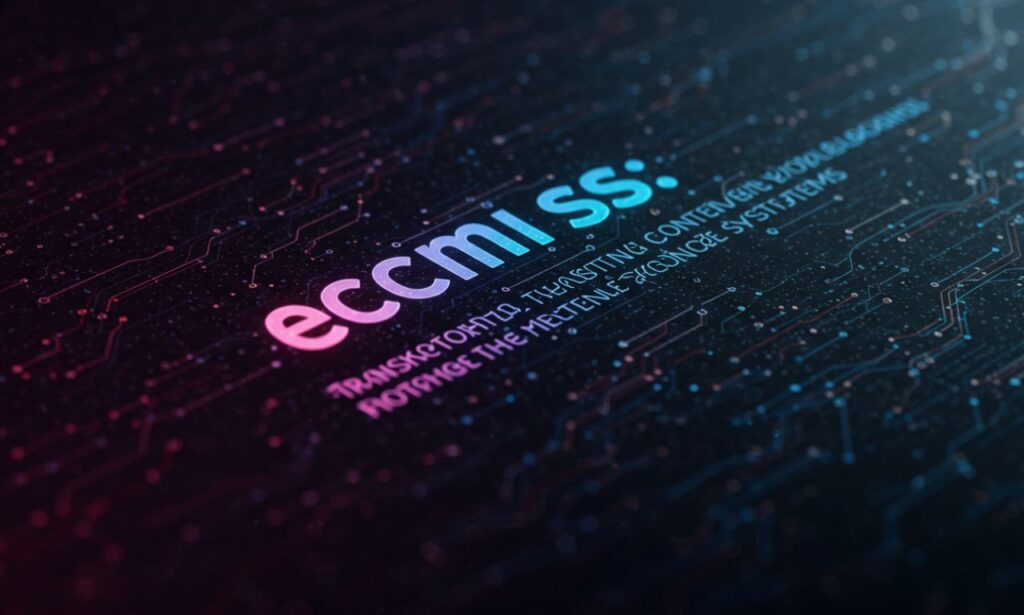In an age where data is both asset and burden, ecmiss emerges as a modern solution to a timeless problem: how to manage, process, and leverage information effectively. Whether understood as a content management platform or a computational intelligence framework, ecmiss is gathering attention. This article delves into its forms, features, challenges, applications, and future — giving you a fresh, practical perspective.
What is ecmiss?
At its core, ecmiss is a concept or system that bridges content, information, and intelligent systems. In many sources, ecmiss is described as Enterprise Content Management and Information System Solution, focusing on organizing, securing, and automating document and data workflows.
However, alternative definitions cast ecmiss in a more AI-centric light: Evolutionary Computational Modeling and Intelligent Systems Structure — a hybrid framework combining computational modeling, evolutionary algorithms, and intelligent decision systems.
In practice, the most common usage centers on content and document management in organizations — so that is the focus we adopt here.
Why is ecmiss gaining traction?
The need for robust content systems is stronger than ever. Companies drown in digital files: reports, contracts, emails, drafts, images. Without structure, many teams waste time hunting for the “right version” or struggle with compliance audits. ecmiss promises to:
-
Centralize content and metadata in one hub
-
Automate repetitive workflows and approvals
-
Enforce versioning, access control, and audit trails
-
Integrate with existing enterprise tools (ERP, CRM, etc.)
-
Scale as data volume and user count grow
By combining structure, automation, and intelligence, ecmiss represents a next step beyond basic document storage.
Key features that make ecmiss stand out
Here are the standout features that distinguish ecmiss from simpler file-sharing or document storage solutions:
Centralized repository with metadata
Rather than dumping files into folders, ecmiss enforces consistent metadata (tags, categories, authors, dates), enabling richer organization and filtering.
Advanced search & OCR
With optical character recognition (OCR) and indexing, users can search inside scanned documents, not just filenames.
Workflow automation
Approval chains, reminders, escalations, and routing can be auto-configured to reduce manual steps.
Version control & audit trails
Every change is logged, with mechanisms to revert to past versions, and maintain accountability for edits.
Role-based security & access
Permissions can be fine-grained: who can view, edit, delete, share, or export a given document.
Integration with enterprise systems
An ecmiss system should talk to the rest of the enterprise tech stack — CRMs, ERPs, email, cloud storage — via APIs or connectors.
Analytics & dashboards
Leaders can see which documents are most accessed, where bottlenecks occur, usage trends, and compliance metrics.
Mobile & remote access
Users increasingly need to access content outside the office — ecmiss often includes responsive design or mobile apps.
Benefits of adopting ecmiss
Implementing ecmiss (properly) can yield multifaceted gains:
-
Efficiency & productivity: Less time spent locating files or following up approvals
-
Lower operational costs: Reduction in paper, physical storage, and manual handling
-
Improved compliance: Audit trails, permissions, and versioning support regulatory demands
-
Error reduction: Automation reduces human mistakes in routing or document handling
-
Better collaboration: Team members see the latest versions, comment, share, and coordinate
-
Scalability: As your organization grows, the ecmiss system scales too
-
Insight through analytics: Identify process bottlenecks, usage patterns, and improve workflow
These advantages make ecmiss a compelling choice for organizations seeking structure amid explosive content growth.
Challenges and pitfalls when implementing ecmiss
No technology is without hurdles. An rollout often faces:
Resistance to change
Employees accustomed to shared drives or email attachments may resist new processes. Training and change management are key.
Data migration complexity
Transitioning legacy documents into — cleaning, tagging, deduplication — is laborious.
Integration friction
Legacy systems, custom tools, or outdated software might not mesh well with modern ecmiss APIs.
Performance & scalability
As content volume grows, search, indexing, and workflow engines may lag unless optimized.
Security risks
A breach in ecmiss affects a central hub; strong encryption, network security, and access controls are critical.
Cost & resource investment
Initial deployment, customization, and staff training require time and capital.
Usability & adoption
If the system is clunky, users won’t adopt it fully, defeating the goals.
Proactive planning, pilot testing, and phased adoption help mitigate these risks.
Real-world use cases and industry applications
Let’s explore how ecmiss is being (or could be) applied across sectors:
Corporate / Enterprise
-
Legal departments manage contracts, revisions, and signatures
-
HR handles policy documents, employee files, onboarding
-
Finance archives invoices, compliance reports, audits
Healthcare
-
Patient records, lab reports, scans, referrals
-
Regulatory compliance, privacy, audit trails
Education & Schools
-
Academic records, transcripts, curriculum content
-
School administration, teacher collaboration, communication with parents
Sources note improves school administration by integrating academic, administrative, and communication functions.
Manufacturing / Engineering
-
Technical manuals, versioned design documents, quality control records
Government / Public Sector
-
Permits, public records, regulations, interdepartmental document flows
Insurance / Banking
-
Customer documents, claims, audit logs, compliance archives
These use cases show how versatile can be.
Steps to successfully implement ecmiss
If your organization considers adopting ecmiss, a recommended roadmap is:
-
Needs assessment & stakeholder buy-in
Identify pain points, content types, compliance needs, and secure leadership support. -
Pilot program / proof of concept
Roll out in one department to test workflows, preferences, and measure impact. -
Data preparation & migration
Clean legacy documents, define metadata taxonomy, and import in stages. -
System configuration & integration
Map workflows, set up user roles, and connect to other business systems. -
User training & adoption
Educate staff with hands-on sessions, documentation, and support channels. -
Monitor, iterate & optimize
Use analytics to refine workflows, permissions, and usability over time. -
Expand deployment
Gradually roll out across departments, customizing per function.
ecmiss and the future: AI, analytics & evolution
As ecmiss matures, several trends are shaping its evolution:
AI-powered classification & auto-tagging
Machine learning can analyze document content and automatically assign metadata without manual tagging.
Predictive workflow suggestions
Based on patterns, the system may propose next steps or automatic routing.
Natural language search
Users may search in conversational language (“Find contract from June 2024”) and get results.
Enhanced integration with AI agents
Chatbots or virtual assistants could fetch, annotate, or summarize documents.
Edge computing & distributed ecmiss
For settings with disconnected operations (e.g. remote sites), decentralized modules that sync back when online.
Stronger compliance and explainability
As audits become more stringent, systems must support explainable decision logs, version traces, and regulatory compliance features.
Cloud & hybrid deployment models
More deployments will use hybrid architectures, blending on-premises security with cloud scale.
These emerging features promise that ecmiss won’t be static — it will evolve alongside enterprise needs.
Tips for high adoption & best practices
-
Start with a metadata taxonomy designed collaboratively — don’t impose blindly
-
Offer easy user interfaces and integrate with familiar tools (email, office apps)
-
Incentivize early adopters and “champions” to lead peer training
-
Monitor usage metrics and engage with low-adoption teams to understand obstacles
-
Keep migration incremental — allow fallback to old systems during transition
-
Provide strong support: helpdesk, documentation, FAQs, troubleshooting
-
Plan for governance: data retention policies, archival rules, clean-up routines
These practices help ensure becomes embraced rather than resisted.
Limitations and realistic expectations
Despite its power, ecmiss is not a silver bullet. Some limitations to bear in mind:
-
It cannot fix poor underlying business process design
-
Over-engineering features can lead to complexity or paralysis
-
Machine-learning features depend on quality data and may err
-
Some users will always prefer ad-hoc sharing tools (email attachments, cloud drives)
-
Upfront costs (software, training, integration) may be high
Adopting should be part of a broader digital transformation strategy, not a standalone bandage.
Summary & takeaways
-
ecmiss typically refers to Enterprise Content Management and Information System Solution, a structured, intelligent platform for document and data management
-
It unifies storage, workflows, security, and analytics under one umbrella
-
Key features include metadata indexing, workflow automation, versioning, secure access, and integration
-
The benefits include efficiency, cost savings, compliance, better collaboration, and analytics
-
Implementation requires careful planning: migration, training, pilot programs
-
Its future lies in AI augmentation, predictive workflows, natural language search, and smarter integrations
-
But success depends heavily on adoption, usability, and alignment with business processes
If your organization struggles with document chaos, compliance stress, or productivity drag, (or a system inspired by it) may be a powerful ally. Start small, measure rigorously, and adapt as you grow.
Frequently Asked Questions
What does “ecmiss” stand for?
In the content management domain, is often phrased as Enterprise Content Management & Information System Solution. In other contexts it may be used as Evolutionary Computational Modeling and Intelligent Systems Structure.
Is ecmiss just another document storage tool?
No — unlike simple storage or shared drives, adds layers of workflow automation, access control, audit logs, versioning, and intelligent search to transform how organizations manage content.
Can small businesses use ecmiss?
Yes — many solutions are modular and scalable. Small companies can start with core features and grow usage gradually without overwhelming resources.
How long does implementation take?
It depends on scale: a pilot in one department might take 1–3 months (including migration and training). Full rollout across large enterprises could take 6–18 months.
Does ecmiss require on-site servers or can it be cloud-based?
Modern architectures support multiple deployment models — on-premises, cloud, or hybrid — depending on security, compliance, and infrastructure preferences.
What role does AI play in ecmiss?
AI can enhance by automating document classification, suggesting workflows, offering natural language search, and predicting routing or trends based on usage data.







